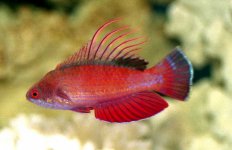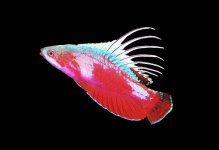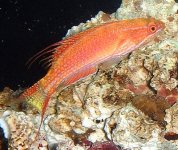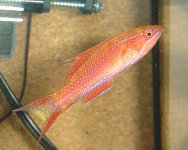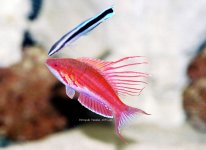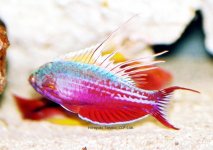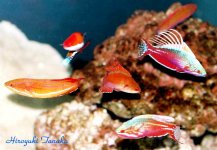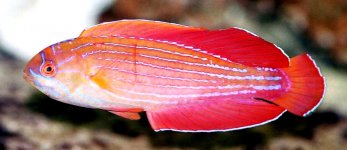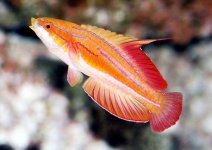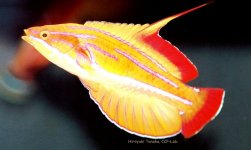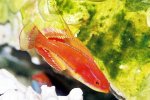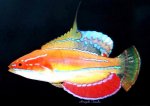Hi Everyone,
Here I started a new column on the Flasher Wrasses (gebus Paracheilinus), a close relative of the Fairy Wrasses (genus Cirrhilabrus). Main difference between these two genera is the count for dorsal-fin spine.
They are also very colorful, mainly orange-red to red, and the genus now comprises 14 different species, and several undescribed ones are known. Their behavior is almost same with that of Cirrhilabrus but members of Paracheilinus with filaments tend to stay near bottom of tanks motionlessly with their bodies almost standing. Of course, all the species will swim in their own way like the Cirrhilabrus members.
A few species of Cirrhilabrus possess filament(s) on dorsal fin but many Paracheiulinus species have a single to eight or more filaments there. They can change their colorations of body and fins like Cirrhilabrus and those are outstanding.
:arrow: List of Species
angulatus*
attenuatus*
bellae
carpenteri*
cyaneus*
filamentosus*
flavianalis*
hemitaeniatus
lineopunctatus*
mccoskeri*
octotaenia*
piscilineatus
rubricaudalis*
togeanensis
Males are different in shape and coloration from females in the same species; in most xases males are larger and more vivid than females. They also are easy to maintain in captive environment and feed on almost anything offered. They are harmless on inverts and suitable for reef-sets and also fish-only tanks, too.
Any species of the genus has short pelvic fins, while many Cirrhilabrus ones possess longer fins.
I have been keeping 10* species out of 14 shown above. I will show all the species I have kept in the aquarium and I hope to 'inspire' anyone who is interested in the genus and Cirrhilabrus as well. Any comment and also photos are highly welcome !
This time I show the Linespot Flasher Wrasse (FW), Paracheilinus lineopunctatus, male in normal coloration. It is an almost entirely deep red fish but it will change its body and fins as shown soon. The timing of this behavior is only seconds, from approximately 3-10". It distributes the Philippines and northern Indonesia and grows to some 7cm or more.
Here I started a new column on the Flasher Wrasses (gebus Paracheilinus), a close relative of the Fairy Wrasses (genus Cirrhilabrus). Main difference between these two genera is the count for dorsal-fin spine.
They are also very colorful, mainly orange-red to red, and the genus now comprises 14 different species, and several undescribed ones are known. Their behavior is almost same with that of Cirrhilabrus but members of Paracheilinus with filaments tend to stay near bottom of tanks motionlessly with their bodies almost standing. Of course, all the species will swim in their own way like the Cirrhilabrus members.
A few species of Cirrhilabrus possess filament(s) on dorsal fin but many Paracheiulinus species have a single to eight or more filaments there. They can change their colorations of body and fins like Cirrhilabrus and those are outstanding.
:arrow: List of Species
angulatus*
attenuatus*
bellae
carpenteri*
cyaneus*
filamentosus*
flavianalis*
hemitaeniatus
lineopunctatus*
mccoskeri*
octotaenia*
piscilineatus
rubricaudalis*
togeanensis
Males are different in shape and coloration from females in the same species; in most xases males are larger and more vivid than females. They also are easy to maintain in captive environment and feed on almost anything offered. They are harmless on inverts and suitable for reef-sets and also fish-only tanks, too.
Any species of the genus has short pelvic fins, while many Cirrhilabrus ones possess longer fins.
I have been keeping 10* species out of 14 shown above. I will show all the species I have kept in the aquarium and I hope to 'inspire' anyone who is interested in the genus and Cirrhilabrus as well. Any comment and also photos are highly welcome !
This time I show the Linespot Flasher Wrasse (FW), Paracheilinus lineopunctatus, male in normal coloration. It is an almost entirely deep red fish but it will change its body and fins as shown soon. The timing of this behavior is only seconds, from approximately 3-10". It distributes the Philippines and northern Indonesia and grows to some 7cm or more.




